
 |
| You might also like: | All About Jewels Glossary: P | All About Jewels Glossary: T | All About Jewels Glossary: K | All About Jewels Glossary: J | All About Jewels Glossary: O | Today's featured page: The Sun K-3 Theme Page |
Illustrated Dictionary of Jewelry |
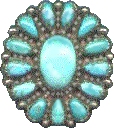 |
||||||
| A | B | C | D | E | F | G | H | I | J | K | L | M | N | O | P | Q | R | S | T | U | V | W | X | Y | Z |
FACET A facet is one of the flat surfaces of a cut stone or glass. |
FACETING Faceting is the cutting and polishing of the surface of a stone. |
FANCY DIAMOND Fancy diamonds are rare diamonds that are red, blue, green, or purple; these diamonds are quite valuable. Diamonds are precious, lustrous gemstones made of highly-compressed carbon; they are one of the hardest materials known. Diamonds have a hardness of 10, a specific gravity of 3.5, and a refractive index of 2.417 - 2.419. |
FANCY CUT Fancy cut stones are cut in unusual ways. Some fancy cuts include the heart, fan, rivoli, trapezium, cathedral window, half-moon (lunette), kite, and triangle. |
FANTASY CUT The fantasy cut is a new way of faceting stones that uses freeform angles - virtually anything goes. |
 FASHION JEWELRY Fashion jewelry is another name for costume jewelry. The Trifari leaf pin above is gold-plated and has glass stones. |
FELDSPAR Feldspars are a family of minerals that include moonstone (adularia), amazonite, sunstone, and labradorite. |
FENICHEL Fenichel is a very rare costume jewelry mark. Fenichel pieces are well made, often using high-quality rhinestones and/or enamel on rhodium-plated metal. |
FERRER'S EMERALD Ferrer's emerald is a glass stone made to imitate an emerald. |
FETISH A fetish is a charm, amulet, pendant or other decoration associated with magical properties; it often represents an animal or person. |
FIBULA A fibula is a brooch (pin) that looks a bit like a safety pin. Fibulas have been used since ancient times to secure clothing. |
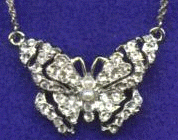 FIGURAL Figural jewelry is disigned to look like real objects. Common subjects are the human body, animals (especially butterflies, dogs, cat, birds, and shells), flowers, leaves, and everyday objects (like baskets and fans). |
FILIGREE Filigree is gold or silver wire that have been twisted into patterns and soldered into place. Openwork filigree is not soldered onto a sheet of metal and is difficult to make. Imitation filigree is made of stamped metal. |
FINDINGS Findings are the parts that jewelers use in making jewelry. For example, clasps, hooks, pin backs, jump rings, and earring backs are findings. |
FINENESS Fineness is the proportion of silver or gold in a metal alloy. Fineness is usually expressed in parts per thousand. For example, the fineness of sterling silver is 925. |
 FIRE A stone's fire is the streaks of brilliant color within it. Good quality opals, like the one above, have a lot of fire. |
FIRE OPAL Fire opals are a type of opal that is fiery orange to red in color (but have no opalescence). These opals are rarely transparent - they are usually milky. Opal is a mineral composed of silica (and some water) and is a species of quartz. Many opals have a high water content - they can dry out and crack if they are not cared for well (opals should be stored in damp cotton wool). Opals have a hardness of 5.5 to 6.5 and a specific gravity of 1.98-2.50. Fire opals are found in Western Australia, Mexico, Brazil, Guatemala, and Honduras. |
FIRESTONE Firestone is an imitation iridescent rainbow quartz. It is made by heating rock crystal until it crazes; iIt is then put into dye as it cools. |
FLAW A flaw is a an imperfection in a gemstone. Flaws include: cracks, inclusions of other minerals or liquid-filled cavities. A flawless stone is called "clean." Flaws can greatly reduce the value of a stone, but in some cases, like moss agate or rutilated quartz, the "flaws" increase the value of the stone. |
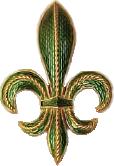 FLEUR DE LIS The fleur de lis (meaning "flower of the lily" in French) is a heraldic symbol of French royalty; it is still used in many French flags. Fleurs de lis are a motif often used in jewelry. The green enamel fleur de lis pin above is by Trifari. |
FLOATER NECKLACE An floater (or invisible) necklace looks as though the beads are simply floating on the skin; the beads or pearls are strung far apart from one another on an almost invisible string (like clear fishing line). |
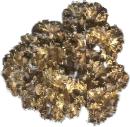 FLORA DANICA Flora Danica is a Danish jewelry company that uses real plant parts to make jewelry. The plant material (usually leaves or sprigs) is electroplated with silver and then gold plated. The delicately-detailed jewelry is used as pins, earrings, pendants, etc. |
FLORENTINE FINISH A Florentine finish on a metal's surface reduces the metal's reflectivity. It is accomplished by engraving parallel lines into the surface using a sharp tool, and then making more lines or curves at right angles (cross-hatching). |
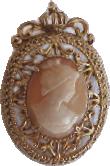 FLORENZA Florenza was a costume jewelry design company started by Daniel Kasoff Inc. in 1948 in New York City. The name Florenza was first used in 1950 (it was named for Kasoff's wife, Florence). Florenza produced pieces until 1981 (when Dan's son Larry, who was then in charge of the company, was injured in a car accident). Florenza made well-designed, intricate (mostly) gold-finished pieces that often contained colored stones (usually pastel, frosted or aurora borealis stones), enameled surfaces, filigree work, intaglio, and/or carved cameos. The styles used were often Renaissance revival/Victorian-inspired pieces, including cameos, Maltese crosses, floral designs, and cherubs. Florenza designed pieces (including cosmetic boxes, compacts, lipstick holders, picture frames, etc.) for other companies, including Estee Lauder and Revlon. The Florenza cameo pin above is hand carved. |
 FLOWERING OBSIDIAN Flowering Obsidian (also called snowflake obsidian) is a volcanic glass that is usually dark (black or brownish) with white "snowflakes". This glassy, lustrous mineral is found in lava flows, and obsidian stones can be massive. Obsidian is formed when viscous lava (from volcanos) cools rapidly. Most obsidian is 70 percent silica. Obsidian has a hardness of 5 and a specific gravity of 2.35. |
FLUORESCENCE Fluorescence is property in which light (or other radiation) is emitted from an object. Many stones (including some diamonds) flouresce when exposed to ultraviolet light. |
FLUORITE Fluorite is a mineral that comes in many colors, including purple, clorless, red, pink, yellow, green, blue, black, and multi-colored stones. Crystals are transparent to translucent. Fluorite is relatively soft - it has a hardness of 4 and a specific gravity of 3.0 - 3.3. The chemical formula for fluorite is CaF2. Fluorite is frequently fluorescent (various varieties fluoresce red, blue, green or yellow light). Fluorite is found all around the world. Some varieties of fluorite include: Blue John (purple with bands of white or yellow), Chlorophane (thermoluminescent - emitting bright green light when heated), Yttrofluorite (yttrium replaces some of the calcium - formula = [Ca,Y]F2), Yttrocerite (cerium and yttrium replaces some of the calcium in its structure - formula = [Ca,Ce,Y]F2, Antozonite (contains uncombined fluorine ions - when fractured or cleaved, it gives off an odd odor). |
FOB A fob is a short chain or ribbon that attaches to a pocketwatch; it frequently had a decorative medallion or other ornament attached to one end. Fobs were worn hanging from a pocket. Fob is also the word for the small pocket in trousers that held a pocket watch. The word fob is also commonly used for the fob charm itself. |
FOILBACK A foilback (or foiled stone) is a stone that has a metallic foil backing; this thin metallic backing is frequently composed of mercury and tin. Silver-colored, gold-colored, or other-colored foil is applied to the back of a stone to make the stone more reflective. Before scintillating cuts (like the brilliant cut) were invented, even precious stones were foiled to enhance their sparkle. Moisture can damage foil and make the stone "dead," losing its brilliance. Stones are rarely foiled any more. |
FOLD OVER CLASP A fold over clasp is a jewelry fastener that is composed of a device that opens and closes with a hinge, and latches shut. It is used to attach the two ends of a necklace or bracelet. |
FOOL'S GOLD Fool's gold is pyrite, a shiny, metallic mineral that looks like gold, but is actually a a form of iron. Marcasite stones come from pyrite. |
FORSTNER Forstner is a mark of the Forstner Chain Corporation of Irvington, New Jersey The company was renamed the Forstner Jewelry Manufacturing Corp. in 1950. Forstner produces silver vermeil and gold-filled jewelry, specializing in chains and snake bracelets. Marks of this costume jewelry company include: Forstner (since January, 1947), Forstner Sterling, Forstner Chain Corp., Forstar (since June, 1950), Bolita, Dapper, Dubl-Lock, F.C.C., Fortune, Merry-Go-Round, Numium, Radio, Snap-Lock, Slide Ring, Trustyle, Union, and FORSIT. |
FOSSIL IVORY Fossil ivory is the tusk of the extinct Woolly Mammoth (an elephant-like animal that lived during the last Ice Ages). |
FOSSILS Fossils are the remains of ancient animals and plants, the traces or impressions of living things from past geologic ages, or the traces of their activities. Fossils can be used to make beautiful jewelry. Fossils came in many different mineral and organic forms, including plain-looking rocks, marble-like casts of ancient animals, opals, and amber (fossilized tree resin). |
FRACTURE A fracture is a crack in a gemstone (also called a feather). |
FREIRICH Freirich was a French costume jewelry, button, and accesory company that was begun by Solomon Freirich in the 1920s after he bought Maison David, a hats, dress ornament and accesory maker. In the USA, the company is called Freirich; in France it is called Maison David (David's House). Freirich also produced buttons for many fashion designers, including Chanel and Dior. The company's increased its costume jewelry production in 1955, when Solomon Freirich's son, Arthur Freirich, joined the firm. The 'FREIRICH' mark was first used on costume jewelry in the 1960s (Freirich jewelry produced before then is unmarked). Freirich jewelry is often Victorian in style, with enamel work, delicate filigrees, glass stones, and metal stamping that emulates granulation. Freirich went out of business in 1990. |
FRENCH ENAMEL French enamel refers to fine enamel work (like the work of Fabergé) the was first developed in France. In this technique, many thin layers of translucent colored enamel (glass paste with colorants) are applied to a metal surface. After firing the piece at temperatures of up to about 820°C, the work is polished. A final layer of clear enamel often covers the piece. Fine miniature paintings in enamel on a white-enamel ground have been produced in France since this technique was developed in 1620-1630 by the French goldsmith Jean Toutin of Chateaudun and other French goldsmiths. |
FRENCH IVORY "French Ivory" is synthetic (imitation) ivory. It is molded from plastics (like celluloid) and is also called Ivoride, Ivorine, and "Genuine French Ivory." |
FRENCH JET French jet is black glass (pyrolusite glass) designed to imitate real jet. It was frequently carved. |
FRESHWATER PEARL A freshwater pearl is a pearl that was harvested from a freshwater mussel (a mollusk). These pearls are frequently shaped like crisped rice cereal, and are less valuable than oyster pearls. Biwa pearls are very good quality freshwater pearls. |
FROST AGATE Frost agate is agate with white markings (that look like frost). |
 FRUIT SALAD "Fruit Salad" jewelry is costume jewelry that is set with colorful, molded stones. The stones are glass or plastic, and can be transparent or translucent. |
 FUCHSITE Fuchsite is a deep emerald green variety of the mineral muscovite that is rich is the chromium. It has a glassy luster. Fuchsite is relatively soft; it has a hardness of 2-2.5 and a specific gravity of 2.77-2.88. The chemical formula for fuchsite is K(Al,Cr)2(AlSi3O10)(OH)2. |
FULL CUT A full cut stone is a gemstone with 58 facets. |
FURNACE GLASS Furnace glass (also called furnace worked glass) is made by working (shaping) hot glass by hand (the glass was heated in a glass furnace). Long tubes of glass are drawn from molten glass, then beads are cut from the tube (and later tumbled and reheated to smooth the edges of the beads). Furnace glass beads are made in a wide variety of colors, shapes, and designs. |
Illustrated Dictionary of Jewelry |
 |
||||||
| A | B | C | D | E | F | G | H | I | J | K | L | M | N | O | P | Q | R | S | T | U | V | W | X | Y | Z |
Enchanted Learning®
Over 35,000 Web Pages
Sample Pages for Prospective Subscribers, or click below
|
Overview of Site What's New Enchanted Learning Home Monthly Activity Calendar Books to Print Site Index K-3 Crafts K-3 Themes Little Explorers Picture dictionary PreK/K Activities Rebus Rhymes Stories Writing Cloze Activities Essay Topics Newspaper Writing Activities Parts of Speech Fiction The Test of Time
|
Biology Animal Printouts Biology Label Printouts Biomes Birds Butterflies Dinosaurs Food Chain Human Anatomy Mammals Plants Rainforests Sharks Whales Physical Sciences: K-12 Astronomy The Earth Geology Hurricanes Landforms Oceans Tsunami Volcano |
Languages Dutch French German Italian Japanese (Romaji) Portuguese Spanish Swedish Geography/History Explorers Flags Geography Inventors US History Other Topics Art and Artists Calendars College Finder Crafts Graphic Organizers Label Me! Printouts Math Music Word Wheels |
Click to read our Privacy Policy
| Search the Enchanted Learning website for: |